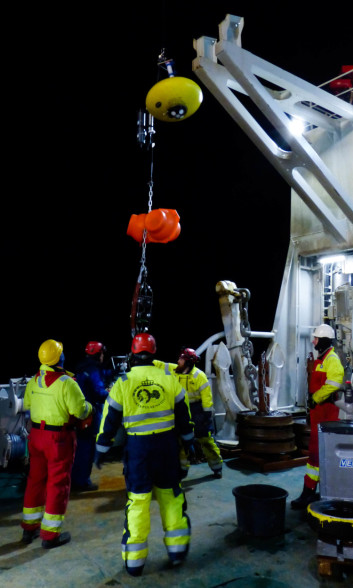
Norwegian Polar Institute and the Institute of
Marine Research. (Photo: Øyvind Lundsgaard)
Four SIOS-InfraNor moorings with lots of instruments measuring the inflow of warm, nutrient-rich Atlantic water north of Svalbard were deployed on a recent cruise with RV Kronprins Haakon. The cruise was a joint (ad)venture between SIOS-InfraNor, A-TWAIN and Nansen Legacy projects. This year has seen a more extensive sea icecover in the Barents Sea than what we have become used to in recent years, so we were not certain that we would be able to accomplish all that was on our wish-list for the cruise. But thanks to a fantastic ship, crew and mooring engineers we made it all the way up to 81 ̊30N, 31 ̊00 E to deploy the new moorings for SIOS.
The main mooring, located near the core of the inflow current at bottom depth 870m, is equipped with current meters, CTDs and biogeochemical sensors (chl-a, nitrate, radiation, pH, oxygen and more). Very close to this one is a pair of moorings each holding an acoustic profiler capable of recording the presence of zooplankton and fish; together these two instruments cover the whole water column from 800m to the surface layer. At 500m depth a trawl-safe bottom frame holds a current meter and a CTD, and at 210m another tall mooring equipped with current meters and CTD plus a sea-ice thickness profiler captures the outer edge of the inflow current.
The deployment area was covered in sea ice when we were there, but operations went well. Below the cold air (around-20 ̊C) and sea ice, Atlantic Water at around 4 ̊C was recorded with the ship-borne CTD. The new moorings will provide data on short-term, seasonal and interannual variability and trends in this major heat supply for the Svalbard area and Arctic Ocean. The plan is to recover and redeploy the moorings in 2021, unless an earlier opportunity arises.
Read more about the Nansen Legacy project and cruises on the project blog.



























